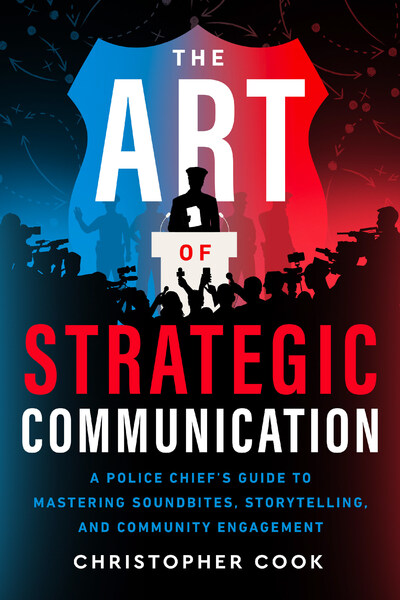Because we no longer live in a world of localized news coverage, few positions within a police department are as vital to community relations success as the strategic communications advisor known as the public information officer. Unfortunately, many police department reputations have been ruined by underestimating the importance of community engagement.

Chief of Police Christopher Cook, author of The Art of Strategic Communication, A Police Chief’s Guide to Mastering Sound Bites, Storytelling and Community Engagement (2024, Indie Books International), shares his expert advice on the crucial role of a strategic communications advisor in a police department.
“You can look across the country and see the failures that affected police chiefs’ careers,” says Cook. “The importance of dealing with the media and engaging with community stakeholders was often miscalculated. A well-trained public information officer and law enforcement leader can influence public outcomes through proven strategies.”
Cook is the Chief of Police and Director of Public Safety for the City of White Settlement, Texas, where he oversees the police and fire departments, and the office of emergency management. With over 30 years of experience in law enforcement and public safety, he is an expert in media relations, homeland security, crime prevention, and critical incident management. He is also pursuing a doctorate in Criminal Justice from Tarleton State University.
Cook joined White Settlement in April 2022, after serving as a Deputy Police Chief for the Arlington Police Department, the seventh largest city in Texas and the 48th largest city in the U.S. He was responsible for the technical services division, which included the FBI Joint Terrorism Task Force.
According to Cook, the position of strategic advisor requires an unusually broad but somewhat specific skill set. He notes that creativity, social media savvy, and social soft skills are important attributes to consider when looking for someone to take on the role.
A startling statistic provided by the U.S. Literacy Project Foundation is that the average reading level in America is equivalent to the seventh or eighth grade. Therefore, the strategic communications advisor must be able to write and edit accordingly because readability can relate to message penetration and how the audience consumes the messages.
Cook emphasizes that the best strategic communications advisors and leaders can tap into a network of professionals and work together for the greater good of the policing profession. A right-fit person is someone who meshes well with not only the chief of police but also the rest of the police force and key figures in the media and political community.

Cook says the chief of police must ensure the individual works well with their leadership style and is aligned with their goal of presenting strategic messaging in the following six ways:
Push The Best Possible Message. Having a central person or office filter the flow of live events can prevent mixed messaging from reaching the various media organizations. This requires obtaining factually based information in a timely manner.
Reach Various Audiences. The range of audiences is much larger than might be suspected. In addition to the news media, there is the pro-police crowd, everyday citizens, anti-law enforcement, haters, trolls, police employees, neighboring law enforcement agencies, elected officials, retirees, and families of former employees, who will all have their own biases when hearing a communication.
Use The Right Channels. Traditional media, such as new channels and newspapers, have been expanded to include social media, YouTube, and podcasts since the 1990s.
Make The Message Easily Understandable. Because a variety of groups may hear the message at any one time, it’s best to reduce it to an easily understood soundbite that can be intertwined with visual and audio storytelling.
Be Timely And Responsive. Best practices suggest providing basic information as quickly and efficiently as possible to answer questions the community would legitimately be interested in. Learn everything about the scene, players involved, location history, prior criminal history, contraband, weapons and other pertinent information.
Ensure The Message Reflects Your Organizational Values, Mission, and Vision. Always ensure transparency with communications and the media.
“We must commit to learning, partnering with peers, attending leadership conferences, and investing in tools and strategies that work in order to train our strategic advisors rather than assuming that effective communication will occur naturally,” says Cook.
Cook stresses the ability to think strategically is the most important characteristic to develop. When asked what to look for in a candidate, He states, “Leaders and communicators must embrace a way of receiving information, assessing it, formulating a plan, executing the strategy and evaluating their effectiveness.”
